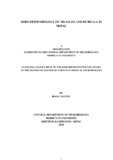Please use this identifier to cite or link to this item:
https://elibrary.tucl.edu.np/handle/123456789/601| Title: | Sero-Epidemiology of measles And rubella in nepal |
| Authors: | Paudel, Bimal |
| Keywords: | Measles, Rubella;epidemiology;serum |
| Issue Date: | 2010 |
| Publisher: | Central Department of Microbiology |
| Institute Name: | Central Department of Microbiology |
| Level: | Masters |
| Abstract: | Background:Measles and Rubella are endemic in Nepal with Measles causinggreatestmorbidity and mortality in children among all vaccine preventable diseases andincreasing no. of Rubella cases posing greater public health challenge of congenitaldefects. Methods:This study was designed to estimate sero-prevalence of Measles and Rubellain Nepalesepopulation based at NPHL, with WHO-IPD. During the period of March2009 to February 2010, a total of 1009 specimens from suspected Measles/Rubella caseswere tested for anti-Measles IgM and anti-Rubella IgM. Results: Out of 1009 suspected cases, 53.5% were male and 46.5% were female. Of thetotal suspected cases tested by ELISA technique, 1.8% cases were Measles positivewhereas 49.7% cases were Rubella positive. Among confirmed Measles positive 55.6%cases were frommale and 44.4% cases were from female similarly 50.5% cases weremale and 49.5% were female among all confirmed Rubella positive. Highest no. ofMeasles positive cases were from age group 5-15 years (44.4%) followed age group 1-5years (38.9%), below 1 year (11.1%) and 15-45 years (5.6%). Collectively 94.4%Measles positive cases were from age group up to 15 years and rest 5.6% from above 15years. Similarly Highest no. of Rubella positive cases were also from age group 5-15years (60.7%) followed by 1-5 years (28.3%), below 1 year (4.2%), 15-45 years (3.2%)and above 45 years (0.2%). Collectively 96.6% Rubella positive cases were from agegroup up to 15 years and rest 3.4% from above 15 years. Measles positive cases wereclustered in summer season (61.1%) with highest in July (44.4%). Most of the Rubellapositive cases were observed in summer season (47.1%) followed by spring season(44.9%) with highest no. in June (113, 22.6%). Among 60 districts, Measles positivecases were observed only from 11 districtswhile Rubella positive cases wereobservedfrom 43 districts. The highest no. of Measles positive cases were confirmed inKathmandu district (27.8%) followed by Doti (22.2%). The highest no. of Rubellapositive cases were observed in Mahottari district (15.6%) followed by Dang (14.2%),Kathmandu (11.4%), Bhaktapur (6.4%) Dhankuta (5.2%) and Gorkha (3.6%). These sixdistricts accounted 56.3% of total Rubella positive cases. Measles positive cases wereequal from CDR and FWDR6(33.3% each). Highest no. of Rubella positive cases werefrom CDR (46.1%) followed by EDR(22.4%), MWDR(16%), WDR(9%) andFWDR(5%). Majority of Measles and Rubella positive cases were from Hill and Terairegion. Higher sero-positivity rate (7.6%) for measles was observed in patients who wereunvaccinated compared to vaccinated (1.2%). Conclusion:The actual Measles and Rubella burden can be estimated by strengtheningand expanding the diagnostic facilities in the country. Further strengthening thevaccination strategies for measles along with need to introduce Rubella containingvaccine in immunization program should be emphasized. Key words: Measles, Rubella, serum, epidemiology, vaccination |
| URI: | http://elibrary.tucl.edu.np/handle/123456789/601 |
| Appears in Collections: | Microbiology |
Files in This Item:
| File | Description | Size | Format | |
|---|---|---|---|---|
| COVER.pdf | 38.76 kB | Adobe PDF |  View/Open | |
| CHAPTER.pdf | 346.62 kB | Adobe PDF |  View/Open |
Items in DSpace are protected by copyright, with all rights reserved, unless otherwise indicated.
